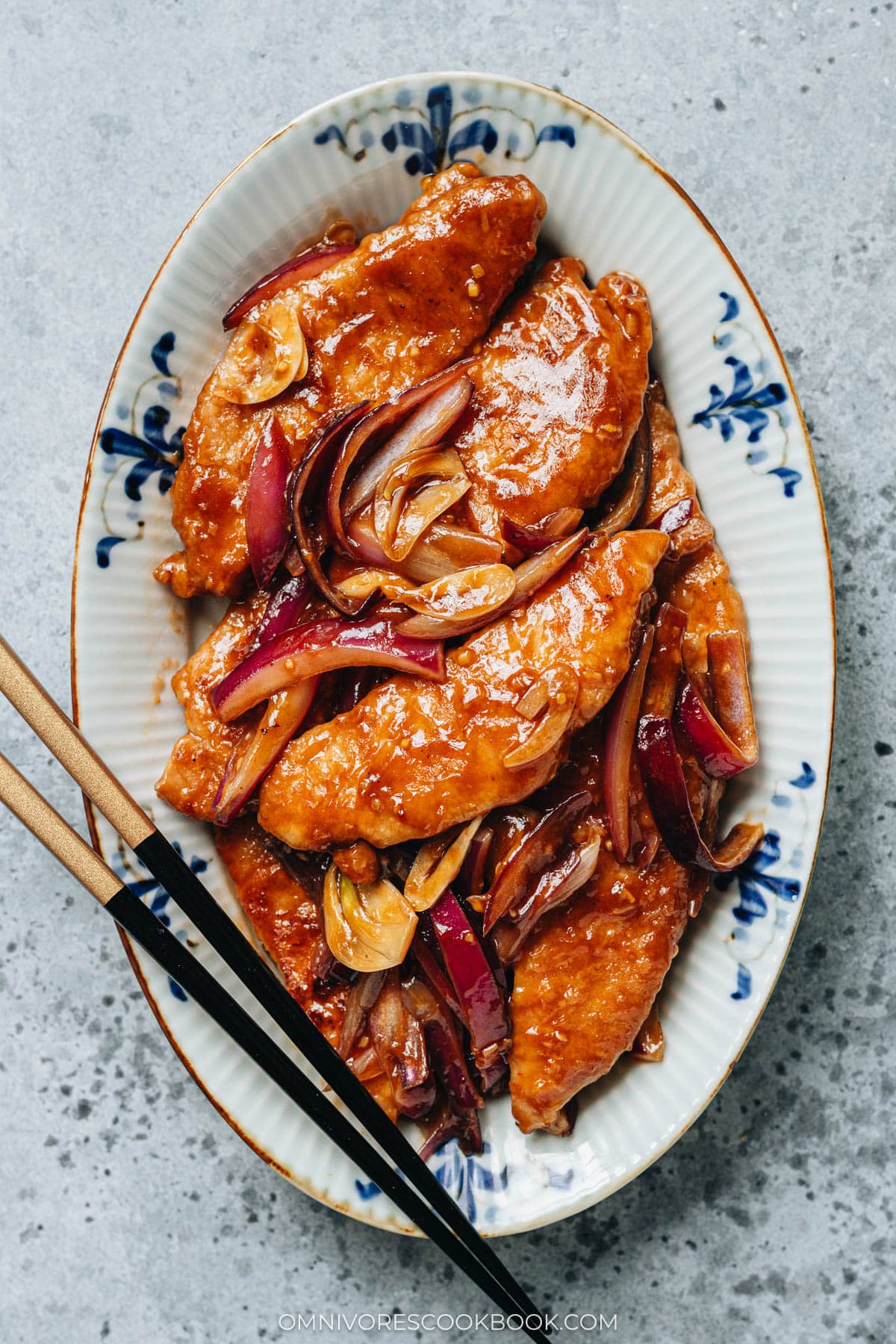
Hong Kong style pan fried pork chops are quite different from the Western style pan fried or deep fried pork chops. Thin sliced pork chops are gently pounded, marinated with a savory sauce for a rich flavor, pan fried until crispy, then tossed with onions and a glossy sauce.
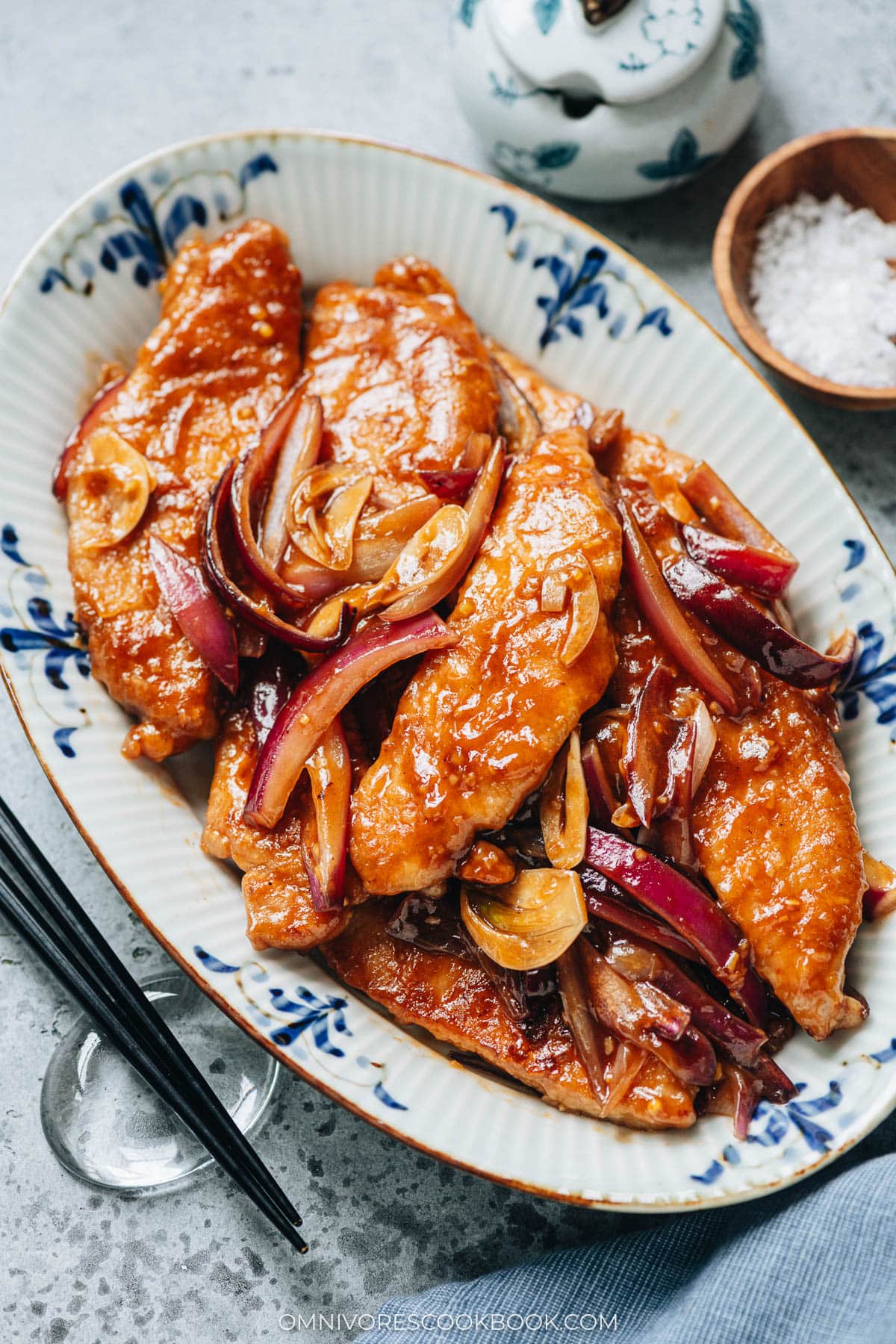
Ingredients
Hong Kong pan fried pork chops use common pantry ingredients. It’s very likely you already have these ingredients if you cook Cantonese recipes often.
- Thin boneless pork chops: If you use bone-in chops, simply remove the bones before cooking.
- Shaoxing wine: It’s used in the marinade to add umami and eliminate gamey flavor from the meat.
- Light soy sauce: It adds flavor to the marinade and sauce without making the dish darker. If not available, you can use regular soy sauce as well.
- Sugar: Sugar balances out the salty flavor, creating a well-rounded sauce.
- Baking soda: It tenderizes the meat and keeps it juicy during high-heat cooking.
- Chicken stock: Creates a rich pan sauce.
- Ketchup: The key ingredient for a rich, savory and sweet sauce.
- Cornstarch: It is used in the pork coating to create a crispy chewy texture, and also in the sauce for a glossy mouthfeel.
- Red onion: It adds texture to the dish and also makes the sauce vibrant.
- Garlic: Fresh aromatics add a ton of flavor to the sauce.
- Ginger: Same as the garlic, it adds fragrance to the sauce.
- Chinkiang vinegar: We use a splash of vinegar to finish up the cooking, making the dish bright and energetic.
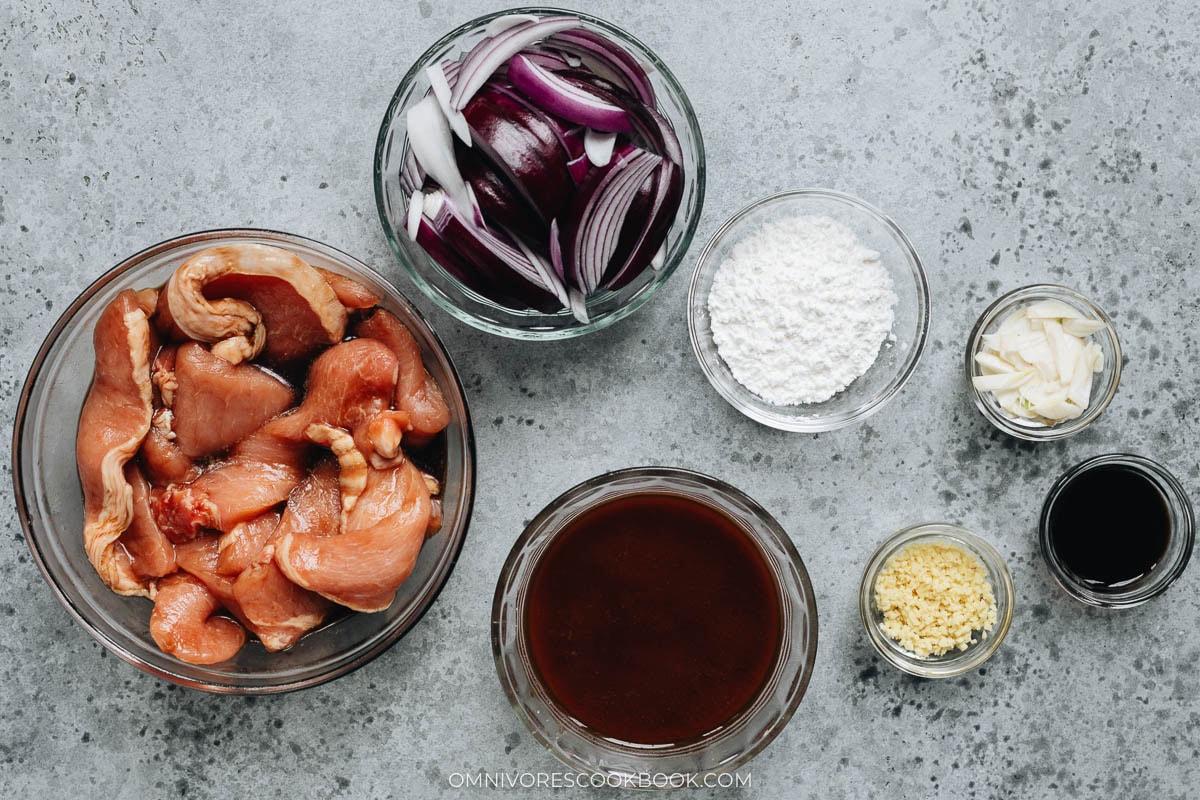
They keys for tender and flavorful pork chops
Preparation before cooking is crucial.
- Use a meat hammer to gently pound the meat to tenderize it. You can see from the picture below that the goal is not to flatten the pork chop into a super thin piece. The goal is to loosen up the chop for a better texture.
- This recipe uses a savory sauce and baking soda to impart a great flavor to the meat and further tenderize it.
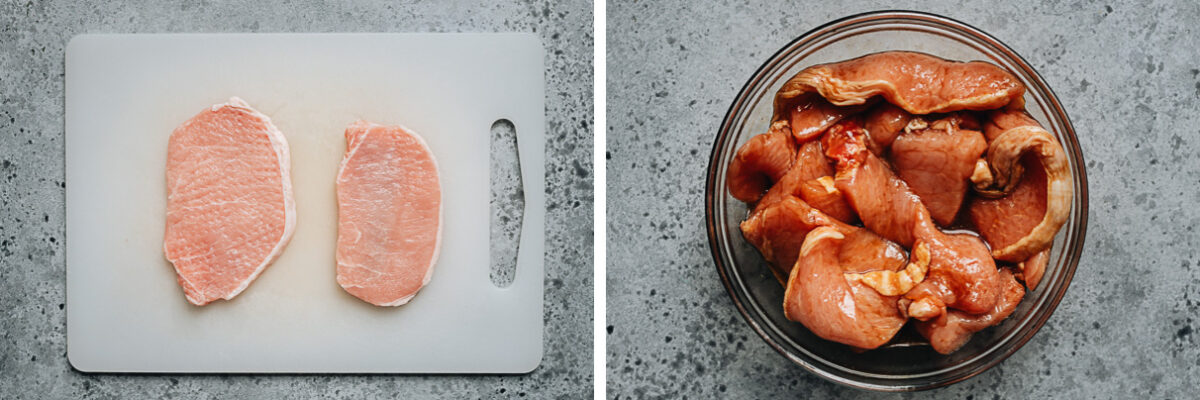
How to make Hong Kong pan fried pork chops
- Coat the pork chops with a thin layer of cornstarch. The cornstarch locks the juice inside of the pork, creating a crispy texture once pan fried.
- Pan fry the pork chops in batches to crisp up the surface while the inside is just cooked through.
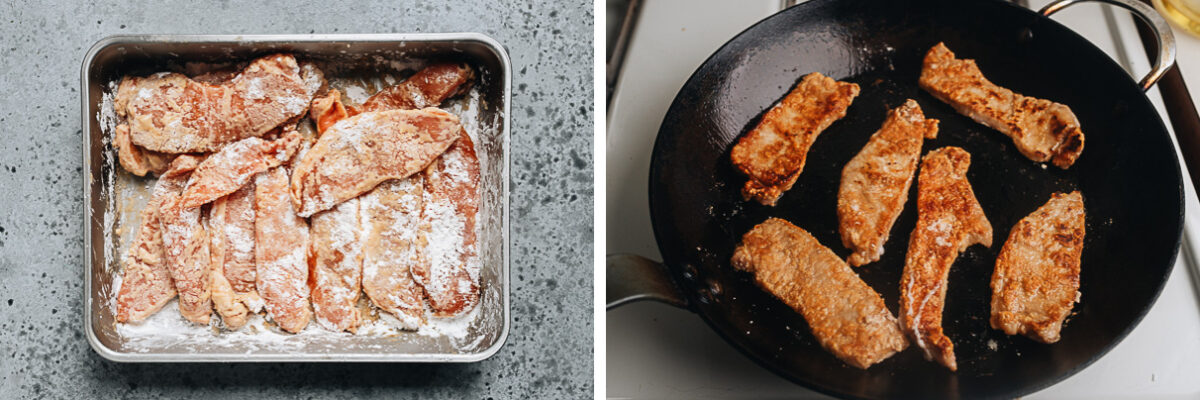
- Quickly cook the aromatics to release fragrance.
- Add the sauce, then cook until it thickens.
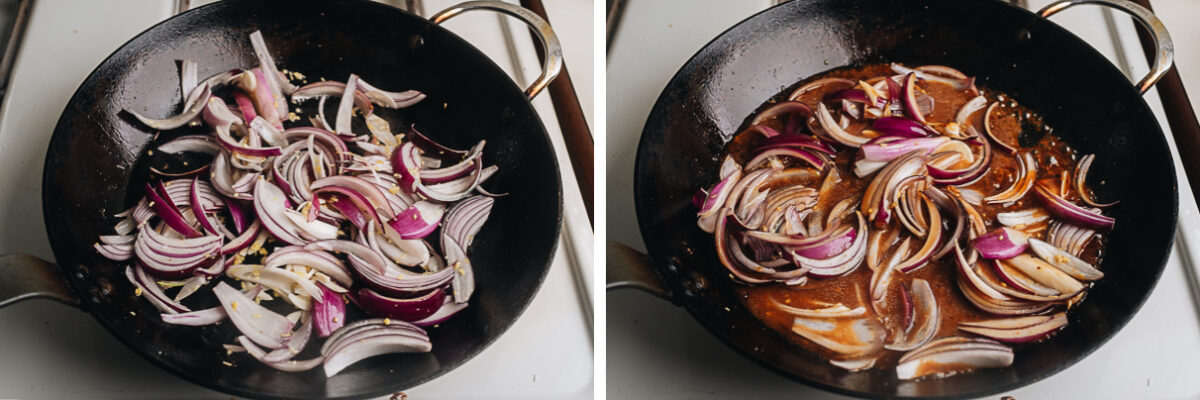
- Add back the cooked pork chops and toss everything together.
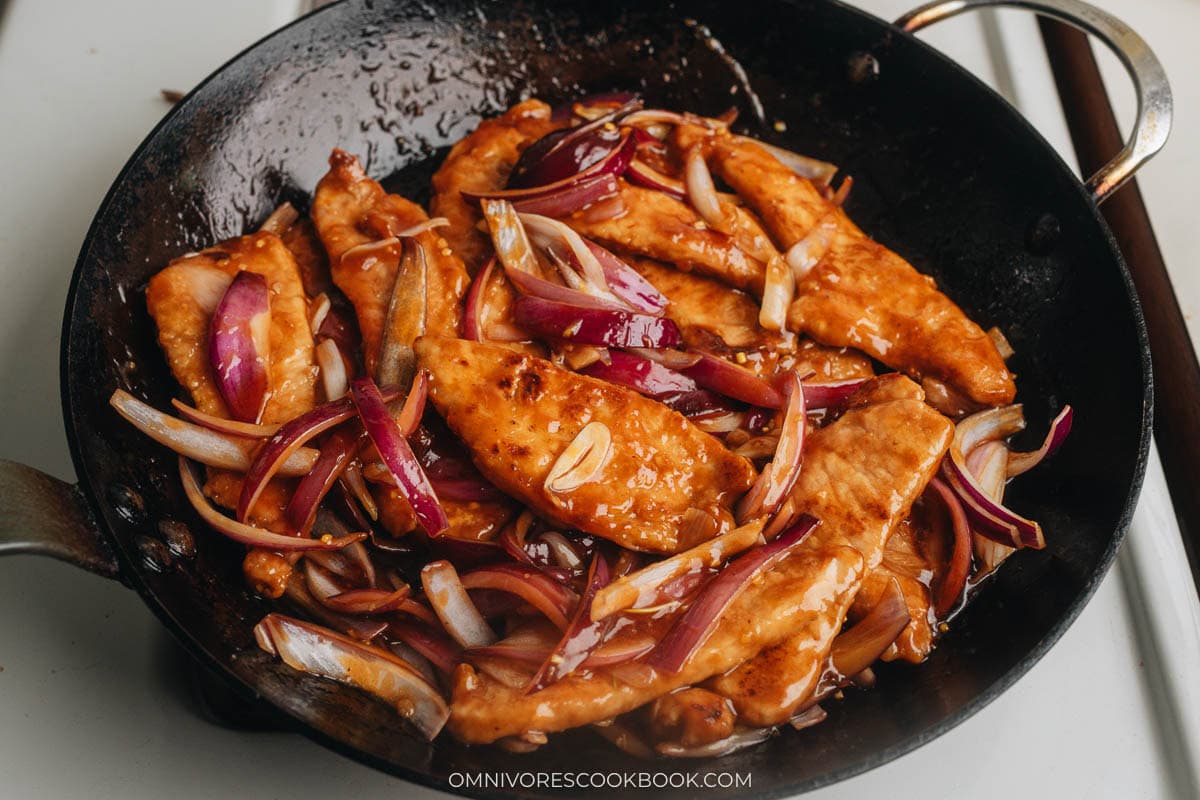
That’s it! The pork chops are crunchy on the outside and tender juicy on the inside. The sauce is savory, sweet and a little tangy, full of aroma from the ginger and garlic. The red onion adds a nice crisp texture and a mild sweet flavor. It’s hard to not gobble down a few chops in one sitting!
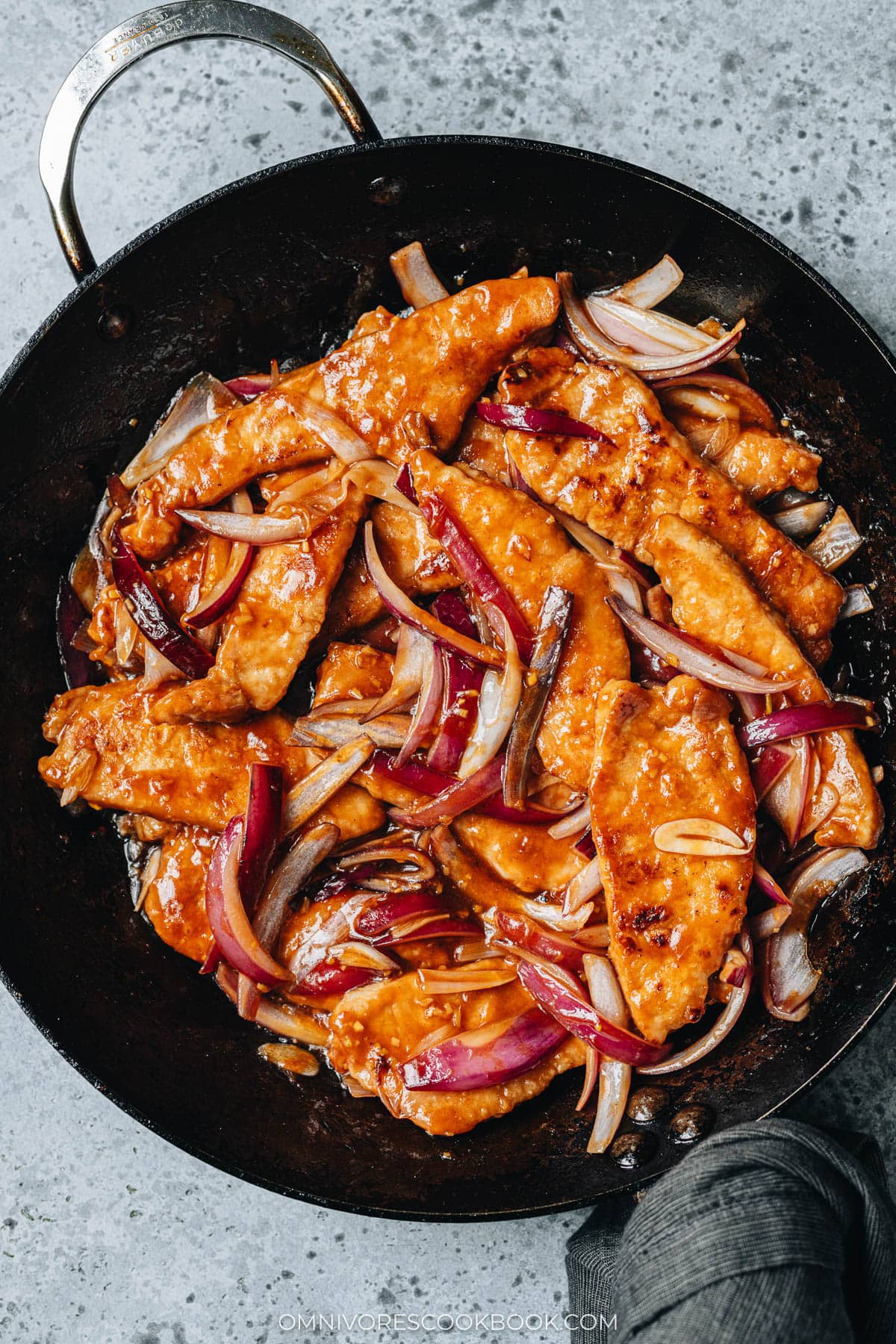
How to serve Hong Kong pan fried pork chops
I like to serve Hong Kong pan fried pork chops over steamed rice, but you can also serve them with egg fried rice. The egg fried rice is super easy to put together and it elevates your meal immediately. You can also serve the pork chops by themselves as a main dish, with a slice of toast and a small salad for a complete meal. For a Sunday dinner, consider serving the dish as a centerpiece, along with roast potatoes or roasted garlic green beans.
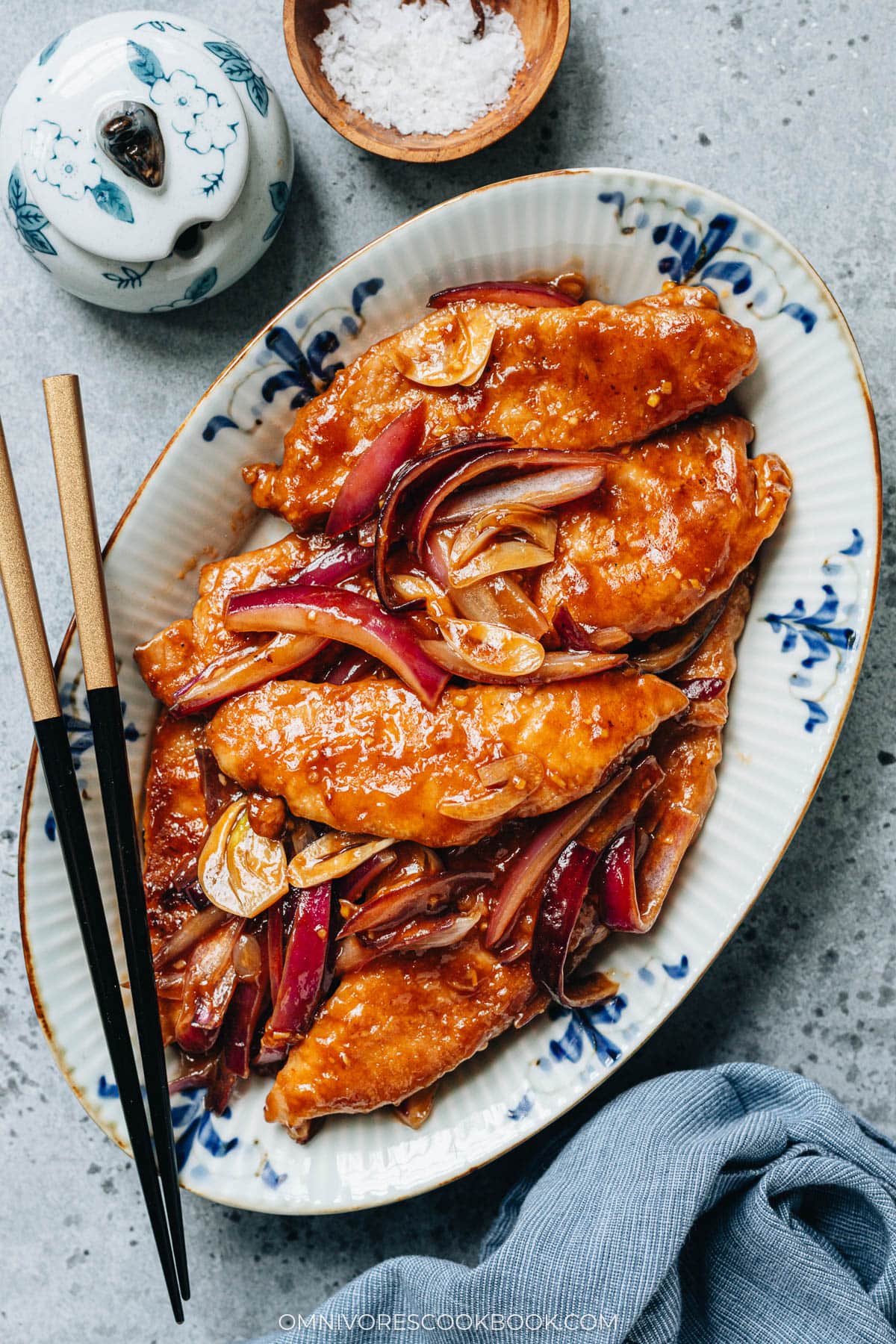
Chinese Cooking Made Easy
Are you new to this website? This free email series is a great place to start. I’ll walk you through a few of my most popular recipes and show you how and why they work. You’ll quickly start to cook better Chinese food in your own kitchen.
Watch video
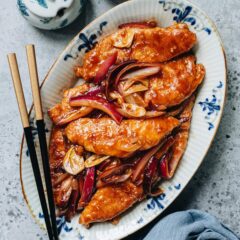
Hong Kong Pan Fried Pork Chops (港式洋葱猪扒)
Ingredients
- 1 lb boneless pork chops (about 1/2” thick)
Marinade
- 1 tablespoon Shaoxing wine
- 1 tablespoon light soy sauce
- 1 teaspoon sugar
- 1/4 teaspoon baking soda
Sauce
- 1/2 cup chicken stock
- 2 tablespoons oyster sauce
- 1 tablespoon ketchup
- 1 tablespoon light soy sauce
- 1 teaspoon sugar
- 2 teaspoons cornstarch
Stir Fry
- 1/3 cup cornstarch
- 2 tablespoons peanut oil (or vegetable oil)
- 1 medium red onion , thickly sliced
- 2 cloves garlic , sliced
- 1 tablespoon ginger , minced
- 1 tablespoon Chinkiang vinegar
Instructions
- If you use bone-in pork chops, remove any bones attached to the meat. Pound each piece to slightly flatten the piece with a meat tenderizing hammer or the back of a knife. (*Footnote 1) Halve the pork chop lengthwise and transfer to a big bowl.
- Add the marinade ingredients to the pork pieces. Mix well and let marinade for 30 minutes.
- Mix all the sauce ingredients together in a medium-sized bowl.
- When you’re ready to cook, transfer the pork chops onto a big tray or plate. Coat with the cornstarch as evenly as you can. Shake off excess starch.
- Heat 1 tablespoon of oil in a large frying pan over medium-high heat until shimmering. Cook the pork chop in batches by adding them to the pan without overlapping. Cook until golden brown on each side, about 2 minutes per side. Once done, transfer the pork chops to a plate. Add more oil if needed when cooking the remaining pork chops.
- Add the remaining 1 tablespoon of oil, the red onion, garlic, and ginger. Stir fry for 1 to 2 minutes so that the onions soften.
- Stir the mixed sauce again and pour into the pan. Stir to mix well until the sauce just starts to thicken.
- Add back the cooked pork chop. Toss to coat everything evenly, 1 minute or so. Turn off the heat and pour in the Chinkiang vinegar. Toss again to mix well. Transfer everything to a large platter. Serve hot by itself or over steamed rice as a main course.
Notes
- The goal isn’t to flatten the pork like a cutlet into a thin piece, but rather to tenderize it while giving it a bit more surface area.
- To make this dish gluten-free: Use dry sherry instead of Shaoxing wine. Use tamari to replace light soy sauce. Make sure to use a gluten-free oyster sauce.
Nutrition

Did you make this recipe?
I’d love to hear how it turned out for you! Please take a moment to leave a 5-star rating ⭐️ and share your thoughts in the comments further down the page. It really helps others discover the recipe too.

Lian
I’m Chinese American but never tried this dish before so thought to give it a shot! Pork chops are tender and very tasty dish but flavor is by no means overpowering. Thank you!!
Jack
I used boneless chicken thighs sliced them in half to be thinner, stayed very moist, left overs were reheated next day still very moist, big hit with family
Eddie
I tried this today, it came out very nice indeed. I think I dropped a bit more than one tablespoon of Chinkiang vinegar, as I didn’t measure it, but even so, all my family was happy with the result.
Great recipe, thank you, Maggie!
Maggie Zhu
Thanks for leaving a positive review and so happy to hear you enjoyed the dish!
The vinegar at the ends add some brightness to the dish and balance out the sweetness of the sauce. I think a bit more vinegar will work just fine 🙂
Eddie
I somehow felt my yesterday effort was not quite what it could’ve been, so I tried again today.
I think the main problem yesterday was I cooked the meat on too high a heat, although it didn’t seem so at the time. The result was the meat was a tad drier than expected.
On today’s edition I fried the chops on medium to low heat (mind, that was on a proper wok burner, not on a gas stove, so allow for that everyone, if you’re reading this). This time I measured the Chinkiang vinegar properly, and I cut back a bit on the sugar in the sauce, since my ketchup was on the sweet side to begin with.
The result was way better than yesterday’s. Not night and day, but noticeably better. That little bit that makes the difference.
So it wasn’t you, Maggie, it’s was me all along lol. Great recipe, I’ll definitely add it on my favorite list. Thanks again!
Maggie Zhu
I’m glad to hear the second time worked out better. A wok burner generates very intensive heat! My current gas stove is super old and weak, the max output is 9000 BTU. I think my highest heat is probably your medium. So medium low heat for searing sounds about right. Thanks so much for sharing your experience and leaving a positive review 🙂
Rita
Is there a substitute for the vinegar?
Maggie Zhu
You can definitely use rice vinegar, cidar vinegar or even distilled vinegar to replace Chinkiang vinegar.
The vinegar adds some brightness to the dish and counter balance the sweetness from the ketchup. That being said, I’ve tried cooking this dish without the vinegar as well and it tasted pretty good too.